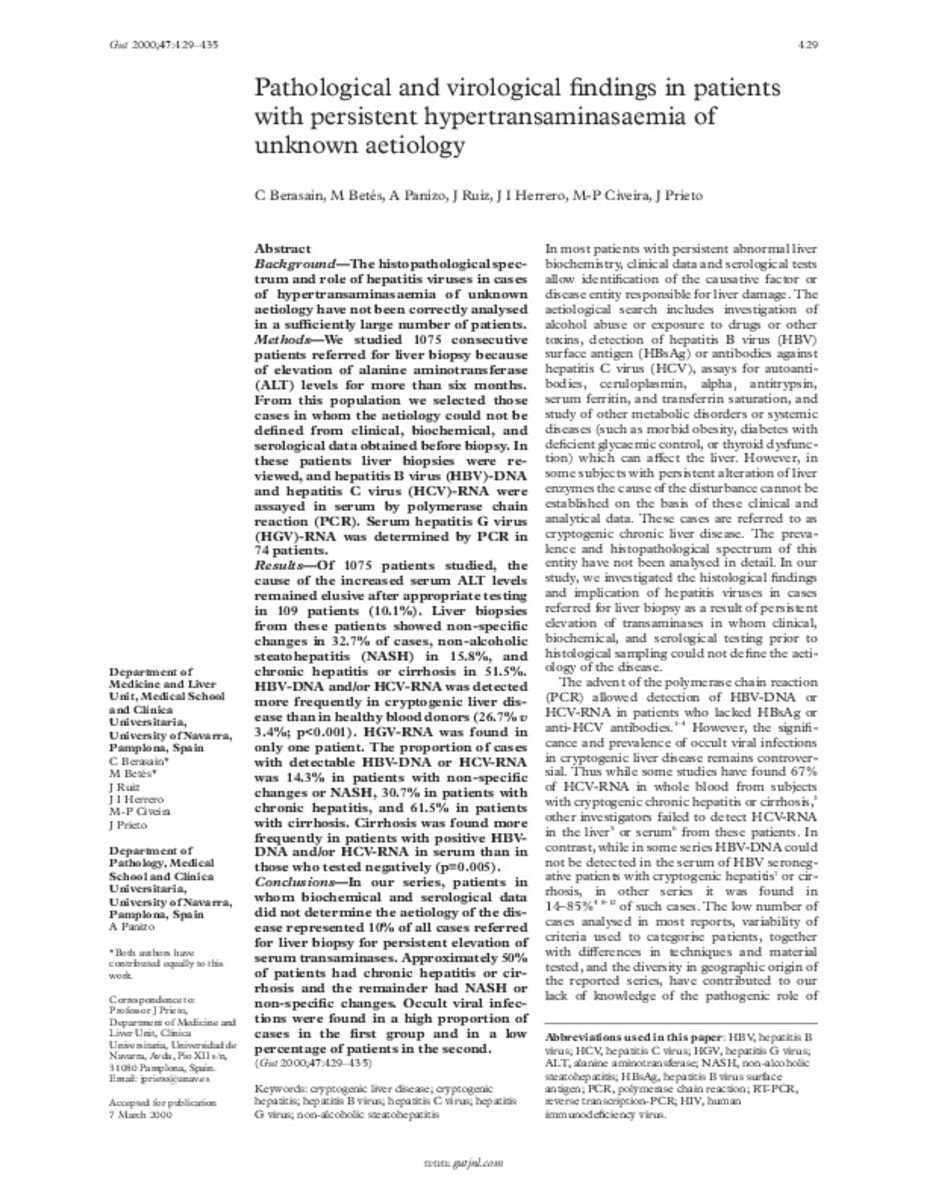Full metadata record
| DC Field | Value | Language |
|---|---|---|
| dc.creator | Berasain, C. (Carmen) | - |
| dc.creator | Betes, M.T. (María Teresa) | - |
| dc.creator | Panizo, A. (Ángel) | - |
| dc.creator | Ruiz, J. (Juan) | - |
| dc.creator | Herrero, J.I. (José Ignacio) | - |
| dc.creator | Civeira, M.P. (María Pilar) | - |
| dc.creator | Prieto, J. (Jesús) | - |
| dc.date.accessioned | 2012-10-08T11:17:59Z | - |
| dc.date.available | 2012-10-08T11:17:59Z | - |
| dc.date.issued | 2000 | - |
| dc.identifier.citation | Berasain C, Betes M, Panizo A, Ruiz J, Herrero JI, Civeira MP, et al. Pathological and virological findings in patients with persistent hypertransaminasaemia of unknown aetiology. Gut 2000 Sep;47(3):429-435. | es_ES |
| dc.identifier.issn | 1468-3288 | - |
| dc.identifier.uri | https://hdl.handle.net/10171/23324 | - |
| dc.description.abstract | BACKGROUND: The histopathological spectrum and role of hepatitis viruses in cases of hypertransaminasaemia of unknown aetiology have not been correctly analysed in a sufficiently large number of patients. METHODS: We studied 1075 consecutive patients referred for liver biopsy because of elevation of alanine aminotransferase (ALT) levels for more than six months. From this population we selected those cases in whom the aetiology could not be defined from clinical, biochemical, and serological data obtained before biopsy. In these patients liver biopsies were reviewed, and hepatitis B virus (HBV)-DNA and hepatitis C virus (HCV)-RNA were assayed in serum by polymerase chain reaction (PCR). Serum hepatitis G virus (HGV)-RNA was determined by PCR in 74 patients. RESULTS: Of 1075 patients studied, the cause of the increased serum ALT levels remained elusive after appropriate testing in 109 patients (10.1%). Liver biopsies from these patients showed non-specific changes in 32.7% of cases, non-alcoholic steatohepatitis (NASH) in 15.8%, and chronic hepatitis or cirrhosis in 51.5%. HBV-DNA and/or HCV-RNA was detected more frequently in cryptogenic liver disease than in healthy blood donors (26.7% v 3.4%; p<0.001). HGV-RNA was found in only one patient. The proportion of cases with detectable HBV-DNA or HCV-RNA was 14.3% in patients with non-specific changes or NASH, 30.7% in patients with chronic hepatitis, and 61.5% in patients with cirrhosis. Cirrhosis was found more frequently in patients with positive HBV-DNA and/or HCV-RNA in serum than in those who tested negatively (p=0.005). CONCLUSIONS: In our series, patients in whom biochemical and serological data did not determine the aetiology of the disease represented 10% of all cases referred for liver biopsy for persistent elevation of serum transaminases. Approximately 50% of patients had chronic hepatitis or cirrhosis and the remainder had NASH or non-specific changes. Occult viral infections were found in a high proportion of cases in the first group and in a low percentage of patients in the second. | es_ES |
| dc.language.iso | eng | es_ES |
| dc.publisher | BMJ Publishing Group | es_ES |
| dc.rights | info:eu-repo/semantics/openAccess | es_ES |
| dc.subject | Cryptogenic liver disease | es_ES |
| dc.subject | Cryptogenic hepatitis | es_ES |
| dc.subject | Hepatitis B virus | es_ES |
| dc.subject | Hepatitis C virus | es_ES |
| dc.subject | Hepatitis G virus | es_ES |
| dc.subject | Non-alcoholic steatohepatitis | es_ES |
| dc.title | Pathological and virological findings in patients with persistent hypertransaminasaemia of unknown aetiology | es_ES |
| dc.type | info:eu-repo/semantics/article | es_ES |
| dc.relation.publisherversion | http://gut.bmj.com/content/47/3/429 | es_ES |
| dc.type.driver | info:eu-repo/semantics/article | es_ES |
Files in This Item:
Statistics and impact
Items in Dadun are protected by copyright, with all rights reserved, unless otherwise indicated.






